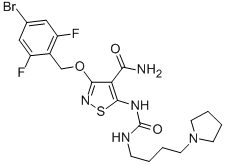All AbMole products are for research use only, cannot be used for human consumption.

CP-547632 is a novel, potent vascular endothelial growth factor receptor-2 tyrosine kinase inhibitor for cancer therapy. Signaling through vascular endothelial growth factor (VEGF) receptors (VEGFRs) is a key pathway initiating endothelial cell proliferation and migration resulting in angiogenesis, a requirement for human tumor growth and metastasis. CP-547632 was identified as a potent inhibitor of the VEGFR-2 and basic fibroblast growth factor (FGF) kinases (IC(50) = 11 and 9 nM, respectively). It is selective relative to epidermal growth factor receptor, platelet-derived growth factor beta, and other related TKs. CP-547632 also inhibits VEGF-stimulated autophosphorylation of VEGFR-2 in a whole cell assay with an IC(50) value of 6 nM. After oral administration of CP-547632 to mice bearing NIH3T3/H-ras tumors, VEGFR-2 phosphorylation in tumors was inhibited in a dose-dependent fashion (EC(50) = 590 ng/ml). CP-547632 did not significantly affect the pharmacologic profiles of paclitaxel and carboplatin. CP-547632 potently inhibits both basic FGF and VEGF-induced angiogenesis in vivo. CP-547632 is a well-tolerated, orally-bioavailable inhibitor presently under clinical investigation for the treatment of human malignancies.
| Cell Experiment | |
|---|---|
| Cell lines | Porcine aortic endothelial cells |
| Preparation method | Cells were seeded at 1.6 × 105 cells/ml in 2-ml growth medium (Ham’s F-12 medium supplemented with 10% FBS, 50,000 units each penicillin and streptomycin, and 500 μg/ml gentamicin) per well in six-well plates. On day 2, the growth medium was replaced with serum-depleted medium (as above, but with 0.1% FBS and 0.1% BSA), and cells were incubated overnight. Immediately before compound addition, the medium was replaced with serum-depleted medium without BSA. Compounds were diluted in 100% DMSO, added to the cells at a final DMSO concentration of 0.25% v/v, and incubated at 37°C for 1 h. The cells were then stimulated with 500 ng/ml VEGF (prepared in serum-depleted medium supplemented with 10 mm NaVO4) and incubated as above for an additional 8 min. The medium was removed and the cells washed once with PBS supplemented with 1 mm NaVO4, then lysed with 1 ml of immunoprecipitation assay buffer [10 mm Tris-HCl (pH 7.5), 50 mm NaCl, 25 mm EDTA, 1% NP40, 0.25% sodium deoxycholate, 2 mm NaVO4, and 1 EDTA-free complete protease inhibitor tablet per 25 ml]. Cell lysates were centrifuged at 14,000 rpm to pellet cellular debris, transferred to a new tube containing 4 μg anti-Flk-1, and incubated with agitation overnight at 4°C. The antibody-protein complex was captured with protein A agarose beads for 30 min at 4°C and the protein boiled off in the presence of DTT. After electrophoresis and transfer to Immobilon-P membranes, the blots were probed with antibodies recognizing either the protein (monoclonal anti-Flk-1) or anti-PY-HRP. After incubation of the blot in enhanced chemiluminescence reagent, bands were visualized on film or using the Lumi-ImagerF1. |
| Concentrations | 0~10 μ M |
| Incubation time | 1 h |
| Animal Experiment | |
|---|---|
| Animal models | athymic mice bearing Colo-205, DLD-1; and MDA-MB-231 cells tumour xenograft |
| Formulation | 5% Gelucire |
| Dosages | 6.25–100 mg/kg qd. for 24 days |
| Administration | oral gavage |
| Molecular Weight | 532.4 |
| Formula | C20H24BrF2N5O3S |
| CAS Number | 252003-65-9 |
| Solubility (25°C) | DMSO |
| Storage |
Powder -20°C 3 years ; 4°C 2 years In solvent -80°C 6 months ; -20°C 1 month |
| Related VEGFR/PDGFR Products |
|---|
| SU5208
SU5208 inhibits vascular endothelial growth factor receptor-2 (VEGFR2). |
| VEGFR-IN-1
VEGFR-IN-1 is a potent angiogenesis inhibitor with IC50s of 0.02, 0.18, 0.24 7.3, and 7 µM for KDR, Flt-1, c-Kit, EGF-R, and c-Src, respectively. |
| (Z)-Orantinib
(Z)-Orantinib ((Z)-SU6668) is a potent, selective, orally active and ATP competitive inhibitor of Flk‐1/KDR, PDGFRβ, and FGFR1, with IC50s of 2.1, 0.008, and 1.2 µM, respectively. |
| (Rac)-SAR131675
(Rac)-SAR131675 is the racemate of SAR131675. |
| AGL 2043
AGL 2043 is an effective inhibitor of PDGFR (IC50=0.8 μM) and TEL-PDGFR kinases, as well as FLT3 and KIT kinases. |
All AbMole products are for research use only, cannot be used for human consumption or veterinary use. We do not provide products or services to individuals. Please comply with the intended use and do not use AbMole products for any other purpose.


Products are for research use only. Not for human use. We do not sell to patients.
© Copyright 2010-2024 AbMole BioScience. All Rights Reserved.
